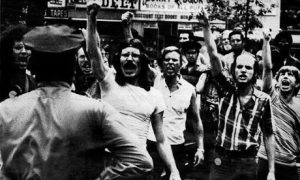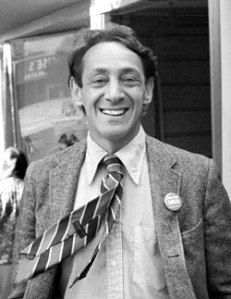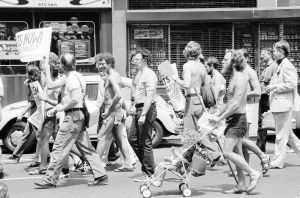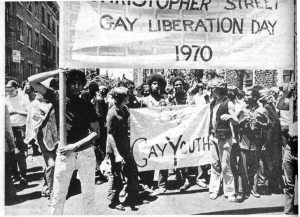The young people coming of age in the late 1960s and into the 1970s were fundamental to the growth of the Cold War era’s gay and lesbian rights movement. Known today at the LGBT movement (lesbian, gay, bisexual, transsexual), the gay rights movement’s first steps were the protests that emerged in 1969 and 1970. This flourishing movement reflected strategies and tactics first used by the Black civil rights movement in the early Cold War era.
Young people with everything to lose demanded freedoms, they argued should be guaranteed to everyone in a democratic United States. As Mark Segal, now 61, leader of the Gay Liberation Front (GLF), one of the first gay rights organization, recently argued in an interview, “The LGBT rights movement was youth.” The vast majority were young people who were struggling in a world where it was illegal for them to live their lives as gay Americans. In order to move from an invisible existence, a myriad of demonstrations and campaigns emulating the civil rights movement were organized from the later 1960s through the 1970s to bring attention to the flourishing gay rights movement.
Stonewall Uprising
Among the many other social movements like women’s rights, Native American rights, Black civil rights, and the anti-war protests, the origins of national gay rights activism sprang from a spontaneous and violent protest at the Stonewall Inn on June 28th, 1969. Some organized calls for civil rights protection for homosexuals originated in the 1950s, especially during the anti-communist hearings held in Congress and led by Senator Joseph McCarthy. Nevertheless, the riot that exploded at the Stonewall Inn in in the Greenwich Village neighborhood in New York City was a turning point for the gay rights movement.

Police confront gay and transvestite protesters in the Stonewall uprising. Photograph: http://www.oldenburg.gay-web.de
During a police raid, the gay and transvestite patrons of the bar refused arrest and fought back. Taking cues from the Black Civil Rights movement, 100 to 150 people congregated outside the bar shouting “Gay power!” and singing “We Shall Overcome,” the anthem of the African American Civil Rights Movement (Carter 147-148). John O’Brien, previous member of the NAACP, Student Peace Union, and participate in Stonewall, comments: “In the Civil Rights Movement, we ran from the police, in the peace movement, we ran from the police. That night, the police ran from us, the lowliest of the low. And it was fantastic.” That night defined a new era for homosexual Americans. The oppressive system that gay and lesbian people faced was no longer acceptable to this group of youth. Lucian Truscott IV, a reporter for The Village Voice, called it “the Rosa Parks moment” for the gay rights movement. Simon Hall, senior lecturer at the University of Leeds, claims that Stonewall was a defining moment that “in public consciousness and historical memory marks the birth of the gay liberation movement” (Hall 546). The momentum that came to life at Stonewall was a turning point for many homosexual youths who realized for the first time that they could push back on the injustices they faced.
Gay Pride March in New York City
Craig Rodwell (30), Fred Sargeant (23), Ellen Broidy (early 20s) and Linda Rhodes (early 20s) organized the first gay pride parade. Broidy and Rhodes were both members of the Gay Student Union and attended New York University. The four organized over twelve gay and lesbian groups to participate in a gay pride march. It was to be held June 28, 1970, a year after the Stonewall uprising. For many young gay people, this was the first time they openly connected themselves to a call for homosexual civil rights. They were risking everything as they make themselves targets to be incarcerated and to be shunned by family, friends, and churches, and employers. The anxiety was palpable, Doric Wilson, a New York playwright in the late 1960s and member of Gays Activist Alliance (GAA) and the GLF, recalled. He hoped that there would be more than 10 people walking in protest, because “it’s all right in the Village, but the minute we cross 14th Street, if there’s only ten of us, God knows what’s going to happen to us.” Those who participated had no idea if they would be able to finish the march.

The second annual Pride Parade in New York City.
Photo: http://www.nydailynews.com/new-york/gay-pride-movement-new-york-city-gallery-1.1100781?pmSlide=1.1100767
They aimed for Central Park, but never knew if they would get there before police or angry bystanders broke them up. They began the march on Christopher Street at 6th Avenue. Jerry Hoose, a young “street kid” recently out of high school and founding member of the GLF, recalls that those involved referred to the march as “The First Run.” The threats of bombs and shots being fired first created a fearful atmosphere, but as the march moved up 6th Avenue, it grew. Wilson said, “I looked back and there were about 2,000 people behind us, and that’s when I knew it had happened … [W]e were ourselves for the first time. America thought we were these homosexual monsters and we were so innocent, and oddly enough, we were so American.” These marches were crucial for the gay and lesbian right movements in order to gain visibility in mainstream America in a positive way. In the spirit of the civil rights movement’s walks, like the March on Washington, these people followed their lead in order to create a place for homosexuals to connect for a cause, creating publicity and fuel for their movement.
Annual Reminder in Philadelphia
Groups of picketers organized by homophile organizations collected outside of Independence Hall in Philadelphia starting on July 4th, 1965. The demonstrations were held until 1969, until after the Stonewall Riots, which they then changed the date to June 28th, 1970 in commemoration of the riot. Martha Shelley (25 during the Stonewall), and a lesbian activist and feminist, recounts her experience picketing: “I did not like parading around while all of these vacationers were standing there eating ice cream and looking at us like we were critters in a zoo.” They held signs reading: “HOMOSEXUAL BILL OF RIGHTS” and “15 MILLION HOMOSEXUAL AMERICANS ASK FOR EQUALITY, OPPORTUNITY, DIGNITY” (Philly Pride). During the picketing, participants demanded legislation that would protect them from discrimination from jobs and being arrested.
They were met with challenges on how to gain respect and positive visibility in order to garner support for the legislative rights that the movement set its goals to. Dick Leitsch, executive director of the Mattachine Society of New York, explains, “We wore suits and ties because we wanted people, in the public, who were wearing suits and ties, to identify with us. We didn’t want to come on, you know, wearing fuzzy sweaters and lipstick, you know, and being freaks. You know, we wanted to be part of the mainstream society.” This was another tactic borrowed by the Black civil rights movements. In marches, picketing, sit-ins, and other demonstrations, blacks would dress in suits and dresses in order to appear more mainstream and respectable. This was done in the hope that the typical American would see this form of conforming to their sensibilities and would identify with the oppressed group.
Harvey Milk’s Election in San Francisco
Homosexual Americans use democracy as a tool in order to gain rights and representation. In the cities and towns where gay and lesbians gathered in sizable numbers, they were able to become large portions of the voting power. Rick Davis, reporter of NBC news on March 14, 1977 reports: “There is a high percentage of gays in this town and they are a political force here … The gay vote is courted by nearly every politician in San Francisco.” San Francisco, California had a sizable homosexual community, giving them the ability to sway elections in their favor. The extension of the voting age in 1971 under Richard Nixon ratified the 26th amendment, lowering the voting age from 21 to 18 in all states. This granted young homosexuals more voting power, which proved to be important in places like San Francisco. Harvey Milk was the first openly gay man elected to public office in 1977 in California as a result of the homosexual and other minority votes coming together.

Harvey Milk in front of his Castro Street, a prominent gay neighborhood, Camera Store, circa 1977. Photo courtesy of Daniel Nicoletta.
He was not involved in the gay rights movement until he around 40 years old, until the counterculture of the 1960s changed him. Milk realized that while the gay’s vote would be in his favor that it was not enough to swing a whole election on its own. In addition to that, he finds that the gay struggle is comparable to many others: “If I’m fighting for the rights of gay people – and I am – then I must fight for the rights of all people. All the minorities, the senior citizens, the handicap, the disenfranchised people, or I’m a hypocrite.” Harvey Milk was a voice that the gay rights movement needed in order to gain positive visibility. While critics complained that Milk was too sensitive, he was a passionate worker that appeared to genuinely care about the position handed to him through the votes of minorities. In his most well-known speech, now labeled “The Hope Speech”, he addresses the importance of people like him being elected: “And you’ve got to elect gay people; so that young child and the thousands upon thousands like that child know that there is hope for a better world. Hope for a better tomorrow.” Milk understood the position he was in and the duty he had to pave a better tomorrow for the minorities of the San Francisco. Unfortunately his time in office was cut short when former Supervisor Dan White assassinated him on November 27, 1978, almost 11 months after Milk was sworn in. The act tore through the gay community, creating a “city in agony” for the loss of Harvey Milk and Mayor Moscone. From this, the gay rights movement saw Harvey Milk as a martyr, who still stands as one of the most known out homosexual in a political office. The homosexual community similarly views Harvey Milk as the idolized Martin Luther King Jr. is by the Black civil rights movement who was also assassinated. These two men gave nonviolent answers to the civil right issues they faced, resulting in them becoming representatives to their causes.

Gay rights demonstration at the Democratic National Convention in 1976. Photo: Leffler, Warren K., photographer.
Through marches, picketing, elections, and demonstrations that emulated the Black civil rights movement, the homosexual rights movement made a lot of progress coming off of the Stonewall uprising through the 1970s. It is through brave actions of the youth that put their lives on the line to push back against the oppressive system that they made great leaps during this time. However, this progress becomes stalled when the HIV/AIDS epidemic became prevalent within the gay community, resulting in increased discrimination. The headway of those who acted during the Stonewall uprising and through the many demonstrations of the 1970s was not lost, as visibility brought awareness to the gay and lesbian plight in America.
-Jillian Jaspan, student of Rutgers, Camden
Bibliography
Primary Sources
“1970s News Clips on Gay Rights.” 24 Nov. 2014. Youtube.
Before Stonewall. Dir. Greta Schiller and Robert Rosenberg. Cinema Guild, 1985. YouTube.
“Boys Beware”. 1961. 24 Nov. 2014. Youtube.
Doty, Robert. The New,York Times. “Growth of Overt Homosexuality in City
Provokes Wide Concern.” New York Times (1923-Current file): 1. Dec 17 ProQuest. Web. 15 Oct. 2014 .
“Give Them Hope – Harvey Milk.” 5 March. 2013. 24 Nov. 2014. Youtube.
John G. “Is Homosexuality A Crime?” New York Times (1923-Current file): 3. Jun 27 1965. ProQuest. Web. 15 Oct. 2014 .
Stonewall Uprising. Dir. Kate Davis and David Heilbroner. PBS American Experience, 2010. Amazon Prime Instant Video.
Segal, Mark. Interviewed by Jillian Jaspan. Telephone interview. 5 Nov. 2014.
Sargeant, Fred. “1970: A First-Person Account of the First Gay Pride March.” New York News and Events. The Village Voice, 22 June 2010. Web. 23 Nov. 2014.
United States Government Printing Office. “Reduction of Voting Age: Twenty Sixth Amendment”. gov.
William Way LGBT Community Center, 1315 Spruce Street, Philadelphia.
Secondary Sources
Carter, David. Stonewall: The Riots That Sparked the Gay Revolution. New York: St. Martin’s, 2004. Print.
Chauncey George, Jessica Shatan, Archie Ferguson, and Vicki Gold Levi.Gay New York: Gender, Urban Culture, and the Making of the Gay Male World, 1890-1940. New York: Basic, 1994. Print.
Garber, Eric. “A Spectacle in Color: The Lesbian and Gay Subculture of Jazz Age Harlem.” The University of Virginia, n.d. Web. 17 Nov. 2014.
Gorton, D. (1998). The origins of anti-sodomy laws. The Harvard Gay & Lesbian Review, 5(1), 10.
Hall, Simon. “The American Gay Rights Movement And Patriotic Protest.” Journal Of The History Of Sexuality 19.3 (2010): 536- 562. Academic Search Premier. Web. 18 Nov. 2014.
“Mark Segal, The Gay Raiders And Walter Cronkite: That’s The Way It Was.” Philebrity. N.p., 20 July 2009. Web. 18 Nov. 2014.
“Philly Pride Remembers and Celebrates the “Annual Reminders.”.” Philly Pride. Philly Pride Presents, n.d. Web. 23 Nov. 2014.
Segal, Mark. “Mark My Words.” PGN. Philadelphia Gay News, n.d. Web. 18 Nov.2014.
Skiba, Bob. “Gayborhood.” Encyclopedia of Greater Philadelphia, 2014. Web. 18 Nov. 2014.
Skiba, Bob. “The Roots Of The Gayborhood, The Eve Of A Milestone.”Hidden City Philadelphia. N.p., 14 Feb. 2014. Web. 18 Nov. 2014.
Smith, Patricia Juliana. The Queer Sixties. New York: Routledge, 1999. Print.


